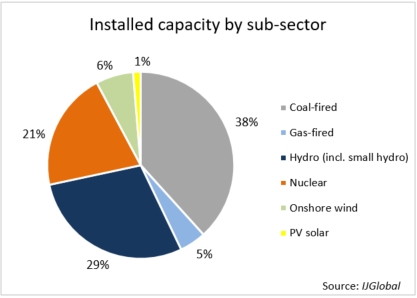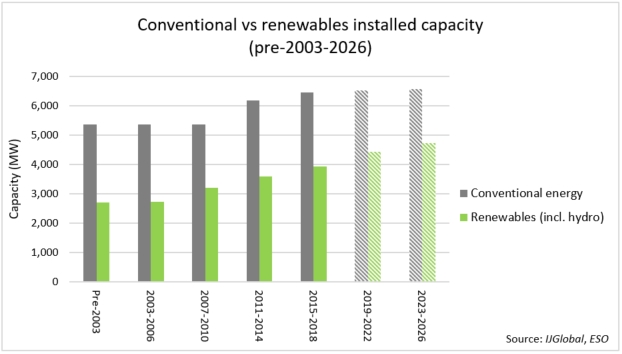Bulgaria's contentious energy mix
Huge uncertainty surrounds planned new nuclear power units and existing coal-fired plants in Bulgaria, which should create opportunities for other types of generation. However, renewable energy development and generation has slowed in the country in recent years.
State-owned Natsionalna Elektricheska Kompania (NEK) is due to pick a private partner for the 2GW Belene nuclear power station in 2019, with reported interest from:
- China National Nuclear Corporation (CNNC)
- Korea Hydro and Nuclear Power
- Framatome – a French reactor business owned by Électricité de France, Mitsubishi Heavy Industries and Assystem
- GE
The Lv9-20 billion ($5.2-11.5 billion) project has suffered several false starts, though, and a target to have completed construction in eight years looks optimistic given public opposition.
Plans to add a new unit at the Kozloduy nuclear power station look even more uncertain given a court decision in May 2018 to reject its environmental impact assessment.
Renewable energy should be well-placed to plug this gap, particularly given the base of renewables projects already active in the country.
Renewables
Largely due to generous feed-in tariffs introduced in a rush to modernise its heavily regulated energy sector, Bulgaria was among the EU countries that exceeded their national targets for production and consumption of energy from renewable sources under the “Europe 2020” strategy. By 2016 Bulgaria had already passed its 2020 target of 16% renewables, reaching 18.8% of the total power mix.
The country’s Ministry of Energy recently introduced market changes to further boost renewable energy projects. In light of the 1.1GW of new renewables to be connected to the grid by the end of 2026 as forecasted by the Electricity System Operator (ESO), the country leaned in to the EU’s push to replace its feed-in tariff scheme with a more market-based feed-in premium.
The intention is to attract investments into the sector, while taking some of the burden off state utility NEK which is obliged to buy all power generated by renewables.
As of July 2018 renewable energy facilities of 4MW and above started selling their electricity on the Independent Bulgarian Energy Exchange (IBEX), receiving a premium on top of the market price. The premiums disburse from the Security of the Electricity System Fund (SESF) to which all Bulgarian power producers have contributed since mid-2015 – a belated measure to ease budgetary spending on renewables.
As shown by data compiled by IJGlobal, there has been a tangible increase in the energy produced by renewable sources in the period 2011-14, stimulated by feed-in tariffs for smaller scale wind and solar, which led to fragmentation of the capacities and made investments in larger projects a rarity. As tariffs subsequently reduced, renewables have been growing at a much slower pace.
The country boasts a few large-scale renewable energy projects, though all were commissioned before 2012. They account for 383.9MW of installed capacity:
| Project | Capacity | Technology | Ownership |
| St Nikolas Kavarna wind farm | 156MW | Wind | AES Corporation (89%), GEOPOWER (11%) |
| Vetrocom wind farm phase I and II | 72.5MW | Wind | Alpiq (100%) |
| Karadzhalovo solar PV | 60.4MW | Solar | Private investor (58%), ACWA Power (42%) |
| Suvorovo wind farm | 60MW | Wind | Enhol Group (100%) |
| Kaliakra wind farm | 35MW | Wind | Mitsubishi Corporation (70%), INOS (30%) |
Global energy players, such as US-based AES Corporation, Spain's Enhol Group and Japanese Mitsubishi Heavy Industries have all invested in large-scale renewables project in Bulgaria. In 2007, Mitsubishi Heavy Industries – alongside a Bulgarian partner – reached financial close on the Kaliakra wind farm, a deal which involved project finance from JBIC and Mizuho. Meanwhile, having divested its coal assets to ContourGlobal in 2011, Italy's Enel retained ownership of its two Bulgarian wind projects – 21MW Kamen Bryag and 21MW Shabla.
Conventional energy sources

Around one third is produced by nuclear facilities 1GW Kozloduy Unit 5 and 1GW Kozloduy Unit 6. Other large generators include three coal-fired plants: 1,456MW Maritsa Iztok-2, 900MW ContourGlobal Maritsa East 3, and 670MW AES Galabovo.
While two of these coal-fired facilities have been completely rebuilt or thoroughly modernised, the state-owned Maritsa Iztok-2 has been at the centre of an ecological debate given it is the largest coal-fired power plant in the Balkans. Maritsa Iztok-2 might face further issues related to emissions spending and a possible shutdown if not modernised.
Bulgaria comfortably met its early renewables targets and has introduced reforms to accelerate solar and wind developments, but these technologies still only make up a small fraction of total generation. It is yet to be seen whether foreign investors will be attracted to its upcoming renewables projects.
Request a Demo
Interested in IJGlobal? Request a demo to discuss a trial with a member of our team. Talk to the team to explore the value of our asset and transaction databases, our market-leading news, league tables and much more.
